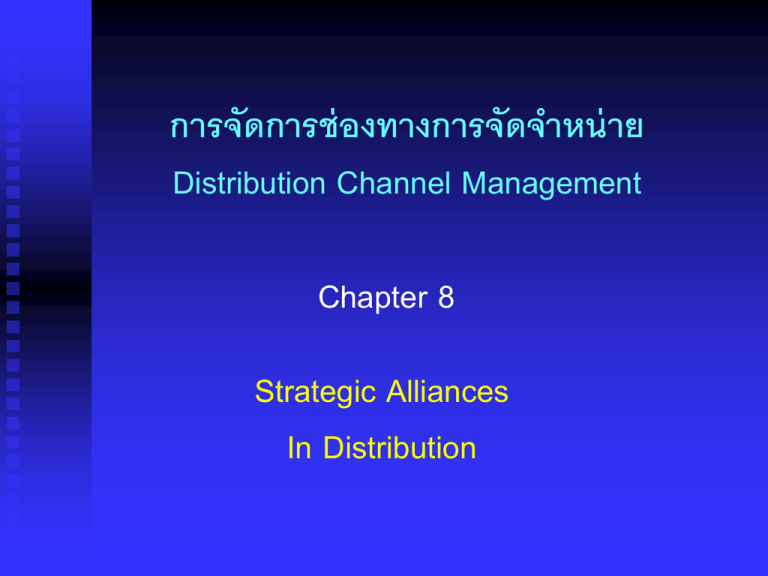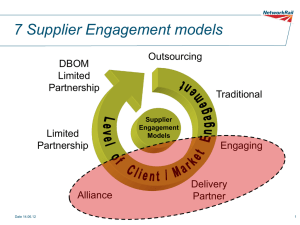Document
advertisement

การจัดการช่ องทางการจัดจาหน่ าย Distribution Channel Management Chapter 8 Strategic Alliances In Distribution Chapter 8 Outlines Learning Objectives - Define and describe the purpose of committed relationships among channel members - Distinguish upstream and downstream motivations to form an alliance - Understand the reason why alliances outperform ordinary channels - Learn how the each member judge the other side credible commitment - Describe the building of commitment by both members based on mutual benefit understanding - Understand commitment building based on economic and noneconomic satisfaction - Differentiate the five stages of a close marketing channel relationship Strategic Alliances in Distribution Points of Discussion - What is the difference between a strategic alliance and other well-functioning marketing channel? - What do the members of the alliance hope to get out of it? - Do they actually gain the benefits they seek? At what Cost? - What characterizes an alliance in distribution? - How can these alliances be built? - Is a distribution alliance worth its cost? Strategic Alliance in Distribution What is a strategic alliance? - Generally when two or more organizations have connections that cause them to function according to a perception of a single interest shared by all the parties - Membership cause each party to alter its behavior to fit the objectives of the alliance - It exhibits genuine commitment - Committed party works hard to maintain and to grow the relationship Strategic Alliance in Distribution The implication of a Commitment - Commitment is a long time horizon - It is an active desire to keep the relationship going - A willingness to make sacrifices to maintain and grow the relationship - Channel members tend to commit in a symmetric way See symptoms of commitment from Figure 8.1 page 291 Strategic Alliance in Distribution Why Strategic Distribution Alliance? – Upstream motives - Expect to gain advantages and profits from downstream channel members (produce to demands, cut inventories, avoid stockouts, etc.) - Appreciate the ability to achieve better coverage at a lower cost - Motivate distributors to represent them better in current markers, new markets, new products Strategic Alliance in Distribution Why Strategic Distribution Alliance? – Upstream motives - Seek to coordinate its marketing efforts - Seek greater cooperation in information exchange (information about sales, inventory level, promotion activities, etc.) - Rebalance the power arrangement from a wave of wholesaling consolidation - Build good distribution network as barriers to entry by new competitors in the future Strategic Alliance in Distribution Why Strategic Distribution Alliance? – Downstream motives - Downstream members assure stable product supplies - Make their own marketing efforts more successful - Seek to cut stock costs and suffer few out-of-stock situations - Build alliances to differentiate themselves from others - Offer value-added services – training, installation, maintenance, technical assistance, etc. Strategic Alliance in Distribution Points of Discussion - Do the parties to an alliance do their calculations correctly? - Do alliances really outperform ordinary channel relationship? Strategic Alliance in Distribution Alliances outperform ordinary channels due to Committed parties trust each other to - do more for each other - go out of their way to help each other - easier to come to agreement - easier to work out conflicts - help each other to cope with unfavorable outcomes and turn them around - evidence indicates that channel partnerships generate higher profits together Strategic Alliance in Distribution How distributor judges supplier’s credible commitment? - Supplier willingly dedicates personnel and facilities to distributor - Supplier eagerness to learn your organization - Using compatible reporting system geared specifically to your system Strategic Alliance in Distribution How distributor judges supplier’s credible commitment? - Investment designed to identify your business and their business in the mind of the customer - Investment such as training programs to help you run your business better - Setting a location near you Strategic Alliance in Distribution Supplier judges distributor’s commitment - Dedication of people and facilities to supplier’s line - Investment in upgrading and training the personnel serving supplier’s line - Efforts to learn about that supplier and build relations with his people Strategic Alliance in Distribution Supplier judges distributor’s commitment - Training of its customers on product information and usages - Efforts to introduce the two parties’ name in customer’s eyes - Investment in reporting system particularly compatible with distributor’s system - Set up a location of a facility closer to distributor Strategic Alliance in Distribution Actions that bind distributors to suppliers - Distributor dedicates resources to suppliers - Build commitment by opening two-way communication - Freely exchange information - Open to supplier to see weakness and strength - Giving advice to supplier from time to time Strategic Alliance in Distribution How to build a strong successful relationship - Alliance is like a balance, a scale - Alliance takes time, risk, resources and determination from both sides - In return for commitment on their part, we say we are committed to you and we prove it Strategic Alliance in Distribution How to build a strong successful relationship - If you make investments, we make investments - If you take risk, we take risk - If you perform, we must perform Two key ingredients to build successful alliance – mutual commitment and high level of trust Building Commitment by The Management Points of Discussion - What is economic satisfaction? - Does economic satisfaction plays a fundamental role in building and maintaining the trust? - Is economic performance a cause or an effect of committed relationships? Building Commitment by The Management The circular logic of building an alliance - Build alliance ---> - Produce outcome ---> - Increase economic satisfaction ---> - Increase trust ---> - Get more commitment from alliance members to build stronger alliance Building Commitment by The Management Non-economic satisfaction coming from - Liberal use of non-coercive influence strategies such as 1. Exchanging information 2. Offer high-quality assistance 3. Making requests - Perceptions of fairness on two fronts 1. Procedural fairness 2. Distributive fairness Marketing Channel Relationship Five Stages of Development to Reach Alliance Status - Stage 1: Awareness - Stage 2: Exploration - Stage 3: Expansion - Stage 4: Commitment - Stage 5: Decline and Dissolution






